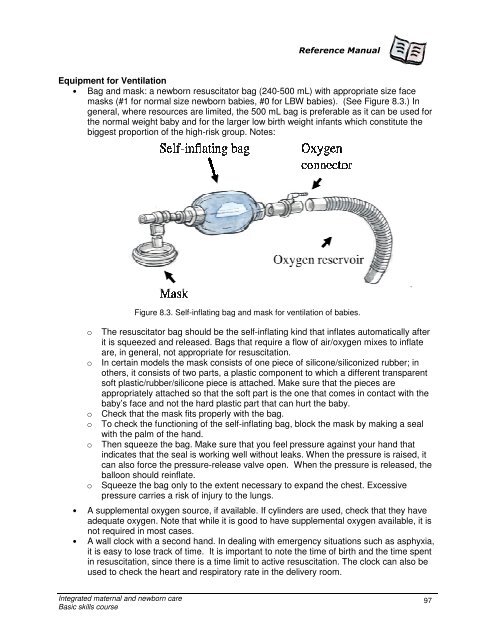Integrated Maternal and Newborn Care Basic Skills Course ...
Integrated Maternal and Newborn Care Basic Skills Course ...
Integrated Maternal and Newborn Care Basic Skills Course ...
Create successful ePaper yourself
Turn your PDF publications into a flip-book with our unique Google optimized e-Paper software.
Reference Manual<br />
Equipment for Ventilation<br />
• Bag <strong>and</strong> mask: a newborn resuscitator bag (240-500 mL) with appropriate size face<br />
masks (#1 for normal size newborn babies, #0 for LBW babies). (See Figure 8.3.) In<br />
general, where resources are limited, the 500 mL bag is preferable as it can be used for<br />
the normal weight baby <strong>and</strong> for the larger low birth weight infants which constitute the<br />
biggest proportion of the high-risk group. Notes:<br />
Figure 8.3. Self-inflating bag <strong>and</strong> mask for ventilation of babies.<br />
o The resuscitator bag should be the self-inflating kind that inflates automatically after<br />
it is squeezed <strong>and</strong> released. Bags that require a flow of air/oxygen mixes to inflate<br />
are, in general, not appropriate for resuscitation.<br />
o In certain models the mask consists of one piece of silicone/siliconized rubber; in<br />
others, it consists of two parts, a plastic component to which a different transparent<br />
soft plastic/rubber/silicone piece is attached. Make sure that the pieces are<br />
appropriately attached so that the soft part is the one that comes in contact with the<br />
baby’s face <strong>and</strong> not the hard plastic part that can hurt the baby.<br />
o Check that the mask fits properly with the bag.<br />
o To check the functioning of the self-inflating bag, block the mask by making a seal<br />
with the palm of the h<strong>and</strong>.<br />
o Then squeeze the bag. Make sure that you feel pressure against your h<strong>and</strong> that<br />
indicates that the seal is working well without leaks. When the pressure is raised, it<br />
can also force the pressure-release valve open. When the pressure is released, the<br />
balloon should reinflate.<br />
o Squeeze the bag only to the extent necessary to exp<strong>and</strong> the chest. Excessive<br />
pressure carries a risk of injury to the lungs.<br />
• A supplemental oxygen source, if available. If cylinders are used, check that they have<br />
adequate oxygen. Note that while it is good to have supplemental oxygen available, it is<br />
not required in most cases.<br />
• A wall clock with a second h<strong>and</strong>. In dealing with emergency situations such as asphyxia,<br />
it is easy to lose track of time. It is important to note the time of birth <strong>and</strong> the time spent<br />
in resuscitation, since there is a time limit to active resuscitation. The clock can also be<br />
used to check the heart <strong>and</strong> respiratory rate in the delivery room.<br />
<strong>Integrated</strong> maternal <strong>and</strong> newborn care<br />
<strong>Basic</strong> skills course<br />
97

















